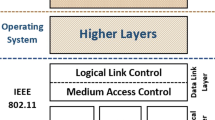Abstract
In this article, we introduce a novel link layer cooperation technique in noisy wireless networks to improve overall system throughput and reliability, and to reduce the cost of retransmission and energy consumption. Under a cluster-based network design, Chase combining (Chase, IEEE Transactions on Communications 33(5):385–393, 1985) is used together with FEC to improve the link layer reliability. This approach is different from how combining is used in the conventional hybrid ARQ, which is in a sequential way. The analytical results and the simulations show that with the cooperation of nodes in a clustering network, the link reliability will be greatly improved with the same power consumption. We also show that not only transmission power is greatly reduced, but also the aggregate power consumption for a successful transmission and reception.












Similar content being viewed by others
Notes
It is unfortunate that we use the term “weight” both for the measure of the quality of a link (w i ) and for the number of ones in a binary sequence (d or W(·)).
References
Azimi-Sadjadi, B., & Mercado, A. (2004). Diversity gain for cooperating nodes in multi-hop wireless networks. In Proceedings of IEEE Vehicular Technology Conference 2004-Fall, Los Angeles, CA, September 2004 (pp. 1483–1487).
Sendonaris, A., Erkip, E., & Aazhang, B. (2003a). User cooperation diversity—part I: System description. IEEE Transactions on Communications, 51(11), 1927–1938.
Sendonaris, A., Erkip, E., & Aazhang, B. (2003b). User cooperation diversity–part II: Implementation aspects and performance analysis. IEEE Transactions on Communications, 51(11), 1939–1948.
Anghel, P., Leus, G., & Kaveh, M. (2002). Distributed space-time coding in cooperative networks. In Proceedings of 5th Nordic Signal Processing Symposium, October 2002.
Laneman, J. N., & Wornell, G. W. (2000). Exploiting distributed spatial diversity in wireless networks. In Proceedings of Allerton Conference of Communications, Control, and Computing, Urbana-Champaign, IL, October 2000.
Laneman, J. N., & Wornell, G. W. (2003). Distributed space-time coded protocols for exploiting cooperative diversity in wireless networks. IEEE Transactions on Information Theory, 49(10), 2415–2425.
Laneman, J. N., Tse, D. N. C., & Wornell, G. W. (2003). Cooperative diversity in wireless networks: Efficient protocols and outage behavior. IEEE Transactions on Information Theory, 50(12), 3062–3080.
Hunter, T., & Nosratinia, A. (2002). Cooperation diversity through coding. In Proceedings of International Symposium on Information Theory, June 2002 (p. 220).
Stefanov, A., & Erkip, E. (2003). Cooperative space-time coding for wireless networks. In Proceedings of IEEE Information Theory Workshop, Paris, France, April 2003 (pp. 50–53).
Scaglione, A., & Hong, Y. (2003). Opportunistic large arrays: Cooperative transmission in wireless multihop ad hoc networks to reach far distances. IEEE Transactions on Signal Processing, 51(8), 2082–2092.
Mercado, A., & Azimi-Sadjadi, B. (2003). Power efficient link for multi-hop wireless networks. In Proceedings of 41st Annual Allerton Conference on Communication, Control, and Computing, Urbana-Champaign, IL, October 2003.
Larsson, P. (2001). Selection diversity forwarding in a multihop packet radio network with fading channel and capture. ACM SIGMOBILE Mobile Computing and Communication Review, 5(4), 47–54.
Nayagam, A., Shea, J. M., & Wong, T. F. (2007). Collaborative decoding in bandwidth-constrained environments. IEEE Journal on Selected Areas in Communications, 25(2), 434–446.
Shea, J. M., Wong, T. F., & Wong, W.-H. (2007). Cooperative-diversity slotted aloha. ACM Wireless Networks, 13(3), 361–369.
Hunter, T. E. (2006). Diversity through coded cooperation. IEEE Transactions on Wireless Communications, 5(2), 1–7.
Chase, D. (1985). Code combining—a maximum-likelihood decoding approach for combining an arbitrary number of noisy packets. IEEE Transactions on Communications, 33(5), 385–393.
Hagenauer, J. (1988). Rate-compatible punctured convolutional codes (RCPC codes) and their applications. IEEE Transactions on Communication, 36(4), 389–400.
Wicker, S. B., & Bartz, M. D. (1994). Type-II hybrid-ARQ protocols using punctured MDS codes. IEEE Transactions on Communication, 42(2), 1431–1440.
Wozencraft, J. M., & Horstein, M. (1961). Coding for two-way channels. In Proceedings on 4th London Symposium On Information Theory, Butterworths, Washington, DC (pp. 11–23).
Harvey, B. A., & Wicker, S. B. (1994). Packet combining systems based on the Viterbi decoder. IEEE Transactions on Communication, 42(2), 1544–1557.
Sindhu, P. (1977). Retransmission error control with memory. IEEE Transactions on Communication, 25(5), 423–429.
Benelli, G. (1985). An ARQ scheme with memory and soft error detectors. IEEE Transactions on Communication, 33(3), 285–288.
Lin, S., & Costello, D. J. (2004). Error Control Coding (2nd Ed.). Pearson Education.
Rappaport, T. S. (2002). Wireless communications: Principles and practice (2nd Ed.). Upper Saddle River: Prentice Hall PTR.
Proakis, J. G. (2001). Digital communications (4th Ed.). New York: McGraw-Hill.
Shih, E., Cho, S.-H., Ickes, N., Min, R., Sinha, A., Wang, A., & Chandrakasan, A. (2001). Physical layer driven protocol and algorithm design for energy-efficient wireless sensor networks. In Proceedings of the 7th Annual International Conference on Mobile Computing and Networking (MobiCom), Rome, Italy, July 2001 (pp. 272–287).
Ettus, M. (1998). System capacity, latency, and power consumption in multi-hop-routed ss-cdma wireless networks. In Proceedings of Radio and Wireless Conference (RAWCON), Colorado Springs, CO, August 1998 (pp. 55–58).
Biswas, S., & Morris, R. (2005). ExOR: Opportunistic multi-hop routing for wireless networks. In Proceedings of ACM SIGCOMM’05, August 2005 (pp. 133–143).
Acknowledgments
This work is supported in part by NSF under contract number NSF-ITR 0313095, and by a grant from Intel Corp.
Author information
Authors and Affiliations
Corresponding author
Rights and permissions
About this article
Cite this article
Yi, S., Kalyanaraman, S., Azimi-Sadjadi, B. et al. Energy-efficient cluster-based cooperative FEC in wireless networks. Wireless Netw 15, 965–977 (2009). https://doi.org/10.1007/s11276-007-0094-x
Published:
Issue Date:
DOI: https://doi.org/10.1007/s11276-007-0094-x




